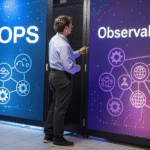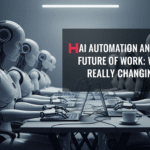Automation Anxiety Peaks as AI Reshapes Office Jobs

As artificial intelligence (AI) transforms office environments, many employees experience automation anxiety—the fear that machines will replace their jobs. While these concerns are valid, it is essential to recognize the many benefits AI brings to the workplace. By understanding both the advantages and potential drawbacks, individuals and organizations can navigate this shift effectively.

AI Automation Anxiety
Automation Anxiety Peaks as AI Reshapes Office Jobs
Automation anxiety is the growing concern that AI and automation technologies will replace human jobs, leading to job losses and uncertainty. Workers in various industries, especially in administrative roles, data entry, and customer service, feel the impact of AI advancements.
A recent PwC report states that 30% of jobs could be automated by the early 2030s. The fear of redundancy leads to stress, uncertainty, and reluctance to adapt. However, AI isn’t just about job loss—it also brings many opportunities to create better, more efficient workplaces.
Why Is AI Reshaping Office Jobs?
Companies integrate AI into daily tasks to improve efficiency, reduce costs, and enhance productivity. AI tools can handle repetitive jobs like scheduling, document processing, and data analysis, allowing employees to focus on higher-value tasks.
For example:
✅ Chatbots handle customer inquiries, reducing workload.
✅ AI-powered analytics help businesses make faster, data-driven decisions.
✅ Automation software streamlines payroll and human resources.
As AI evolves, new jobs will emerge that require critical thinking, creativity, and problem-solving—skills that AI cannot replicate.
Pros of AI in Office Jobs
1️⃣ Boosts Productivity
AI eliminates repetitive, time-consuming tasks, allowing employees to focus on strategic and creative projects. This shift leads to increased job satisfaction and higher efficiency.
🔹 Example: AI scheduling tools help businesses manage meetings, saving time and reducing errors.
2️⃣ Improves Decision-Making
AI processes vast amounts of data in real-time, offering valuable insights that help businesses make smarter decisions. Companies can predict market trends, analyze consumer behavior, and optimize strategies faster.
🔹 Example: AI-powered analytics tools provide real-time business intelligence.
3️⃣ Creates New Job Opportunities
While AI replaces some jobs, it also creates new roles in fields like AI maintenance, data science, cybersecurity, and automation management. Employees can reskill to stay competitive in this evolving job market.
🔹 Example: AI specialists, automation engineers, and chatbot developers are in high demand.
4️⃣ Enhances Employee Well-being
With AI handling mundane tasks, employees have more time for meaningful work, leading to reduced stress and better work-life balance.
🔹 Example: AI in HR automates payroll and recruitment, reducing administrative burdens.
5️⃣ Strengthens Customer Experience
AI-powered chatbots and virtual assistants respond instantly to customer inquiries, improving satisfaction. AI also personalizes customer experiences, enhancing engagement.
🔹 Example: AI-driven email marketing tools suggest tailored content to customers.
Cons of AI in Office Jobs
1️⃣ Job Displacement Risks
AI automates many manual tasks, making some jobs obsolete. Industries such as customer support, finance, and administrative work face the highest risk of job loss.
🔹 Example: AI chatbots replacing call center employees.
2️⃣ Skill Gaps in the Workforce
Not all employees have the skills needed to work alongside AI. Without proper training, many may struggle to adapt.
🔹 Solution: Companies should invest in upskilling programs to help workers transition.
3️⃣ Over-Reliance on AI
Companies may depend too much on AI, reducing human oversight. Mistakes can happen when AI misinterprets data or lacks context.
🔹 Example: AI-generated content may include errors without human review.
4️⃣ Privacy and Security Concerns
AI systems collect and process large amounts of personal data, raising concerns about data security and privacy risks.
🔹 Solution: Strong cybersecurity measures must be in place to protect sensitive information.
5️⃣ Emotional and Psychological Impact
Fear of job loss increases stress among employees, impacting mental health and workplace morale.
🔹 Solution: Companies should communicate transparently about AI adoption and provide support.
How to Overcome Automation Anxiety
✅ Embrace Lifelong Learning
Upskilling is key to staying relevant in an AI-driven workplace. Employees should take online courses and training programs in AI, automation, and digital skills.
✅ Adopt a Growth Mindset
AI can be a valuable tool rather than a threat. Employees should see AI as a collaborator that helps improve their work.
✅ Encourage Open Communication
Employers should discuss AI adoption plans with employees, reducing fear and uncertainty.
✅ Leverage AI for Career Growth
Rather than resisting AI, employees should use it to enhance their work. AI can help improve productivity, learning, and career advancement.

Frequently Asked Questions
1️⃣ What is automation anxiety?
Automation anxiety is the fear that AI and automation will replace human jobs, leading to uncertainty and job loss.
2️⃣ Which jobs are most affected by AI?
Roles in customer service, data entry, accounting, and administrative support face the highest risk of automation.
3️⃣ How can I stay relevant in an AI-driven workplace?
Stay updated with new skills such as AI literacy, data analysis, and problem-solving. Take online courses and gain certifications in AI-related fields.
4️⃣ Will AI completely replace human workers?
No. AI can automate repetitive tasks, but human skills like creativity, empathy, and critical thinking remain irreplaceable.
5️⃣ What can companies do to help employees with automation anxiety?
Companies should provide training programs, communicate openly, and support employees through the transition.
Conclusion
AI is changing the way we work. While automation anxiety is real, it doesn’t have to be scary. Instead of fearing job loss, we should focus on new opportunities. AI makes work faster, smarter, and more efficient, allowing us to do more creative and meaningful tasks.
The key to success? Learn new skills, stay adaptable, and use AI as a tool—not a threat. Companies should also support their employees with training and open conversations about AI’s role.
The future of work isn’t about AI replacing humans—it’s about AI and humans working together to create something better. Embrace the change, upskill, and get ready for an exciting future!



